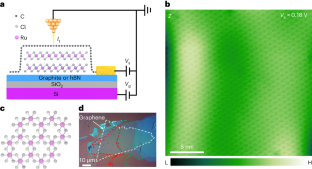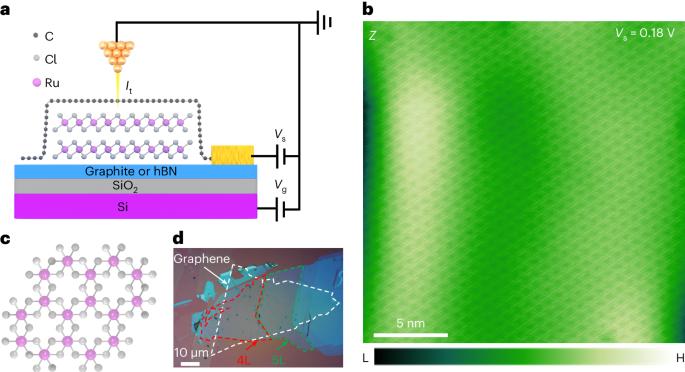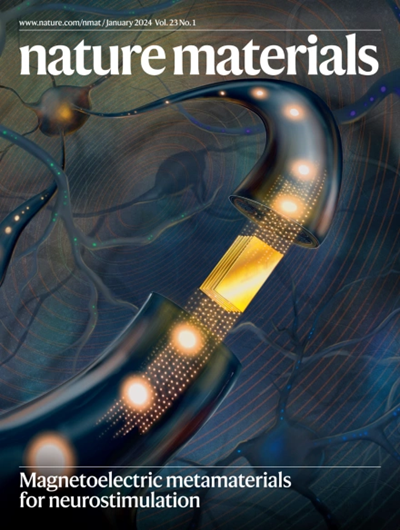Evidence for electron–hole crystals in a Mott insulator
IF 37.2
1区 材料科学
Q1 CHEMISTRY, PHYSICAL
引用次数: 0
Abstract
The coexistence of correlated electron and hole crystals enables the realization of quantum excitonic states, capable of hosting counterflow superfluidity and topological orders with long-range quantum entanglement. Here we report evidence for imbalanced electron–hole crystals in a doped Mott insulator, namely, α-RuCl3, through gate-tunable non-invasive van der Waals doping from graphene. Real-space imaging via scanning tunnelling microscopy reveals two distinct charge orderings at the lower and upper Hubbard band energies, whose origin is attributed to the correlation-driven honeycomb hole crystal composed of hole-rich Ru sites and rotational-symmetry-breaking paired electron crystal composed of electron-rich Ru–Ru bonds, respectively. Moreover, a gate-induced transition of electron–hole crystals is directly visualized, further corroborating their nature as correlation-driven charge crystals. The realization and atom-resolved visualization of imbalanced electron–hole crystals in a doped Mott insulator opens new doors in the search for correlated bosonic states within strongly correlated materials. Scanning tunnelling microscopy of doped RuCl3 shows distinct charge orderings at the lower and upper Hubbard bands, which can be attributed to a correlation-driven honeycomb hole crystal composed of hole-rich Ru sites and a rotational-symmetry-breaking paired electron crystal composed of electron-rich Ru–Ru bonds.


莫特绝缘体中电子-空穴晶体的证据
相关电子晶体和空穴晶体的共存使量子激子态得以实现,能够容纳逆流超流和具有长程量子纠缠的拓扑秩序。在这里,我们报告了在掺杂莫特绝缘体(即α-RuCl3)中,通过石墨烯的门调谐非侵入性范德华掺杂,实现不平衡电子-空穴晶体的证据。通过扫描隧道显微镜进行的实空间成像显示,在哈伯带能的下部和上部存在两种截然不同的电荷有序性,其起源分别是由富含空穴的 Ru 位点组成的相关驱动蜂窝空穴晶体和由富含电子的 Ru-Ru 键组成的旋转对称性破坏配对电子晶体。此外,栅极诱导的电子-空穴晶体转变被直接可视化,进一步证实了它们作为相关驱动电荷晶体的性质。掺杂莫特绝缘体中不平衡电子-空穴晶体的实现和原子分辨可视化为在强相关材料中寻找相关玻色态打开了新的大门。
本文章由计算机程序翻译,如有差异,请以英文原文为准。
求助全文
约1分钟内获得全文
求助全文
来源期刊

Nature Materials
工程技术-材料科学:综合
CiteScore
62.20
自引率
0.70%
发文量
221
审稿时长
3.2 months
期刊介绍:
Nature Materials is a monthly multi-disciplinary journal aimed at bringing together cutting-edge research across the entire spectrum of materials science and engineering. It covers all applied and fundamental aspects of the synthesis/processing, structure/composition, properties, and performance of materials. The journal recognizes that materials research has an increasing impact on classical disciplines such as physics, chemistry, and biology.
Additionally, Nature Materials provides a forum for the development of a common identity among materials scientists and encourages interdisciplinary collaboration. It takes an integrated and balanced approach to all areas of materials research, fostering the exchange of ideas between scientists involved in different disciplines.
Nature Materials is an invaluable resource for scientists in academia and industry who are active in discovering and developing materials and materials-related concepts. It offers engaging and informative papers of exceptional significance and quality, with the aim of influencing the development of society in the future.
 求助内容:
求助内容: 应助结果提醒方式:
应助结果提醒方式:


